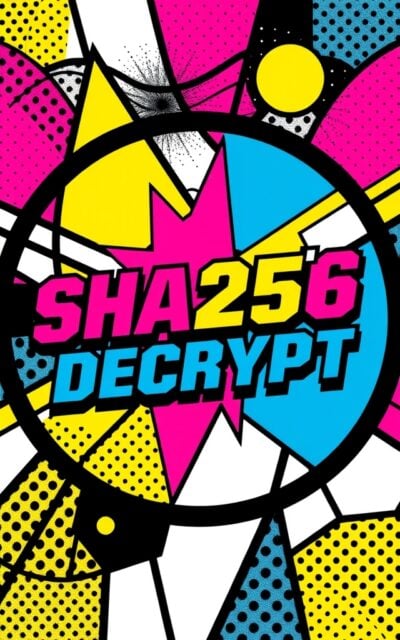SHA256 Decrypt
Attempt to reverse SHA256 hashes with our SHA256 decrypt tool and understand the limitations of reversing cryptographic hash functions.
Updates
3 more million common hashes added! SHA256 Decrypt Tool now supports precomputed hashes with more than 11 million entries.
Guide
What is SHA256 Decrypt?
SHA256 Decrypt is a tool that attempts to reverse the SHA256 hashing process and retrieve the original input data from a given SHA256 hash value. SHA256 is a cryptographic hash function that generates a fixed-size 256-bit (32-byte) hash value from an input of any size.
However, it’s important to note that SHA256, like other cryptographic hash functions, is designed to be a one-way function. This means that it is computationally infeasible to reverse the hashing process and obtain the original input data from the hash value alone.
Limitations of SHA256 Decryption
- One-way function: SHA256 is a one-way hash function, meaning that it is not intended to be reversible. The process of generating a hash value from an input is designed to be computationally easy, while the reverse process of obtaining the original input from the hash value is computationally infeasible.
- Collision resistance: SHA256 is collision-resistant, which means that it is highly unlikely to find two different inputs that produce the same hash value. This property ensures the integrity and uniqueness of the hash values.
- Deterministic output: SHA256 always produces the same hash value for the same input. This deterministic behavior is essential for verifying the integrity of data, but it also means that decryption is not possible without additional information.
Alternatives to SHA256 Decryption
Given the limitations of SHA256 decryption, here are some alternative approaches:
- Brute-force attack: One way to attempt decryption is by using a brute-force attack, which involves systematically trying all possible input combinations until a match is found. However, this approach is computationally expensive and impractical for most cases, especially with the large keyspace of SHA256.
- Dictionary attack: If the original input is suspected to be a common word or phrase, a dictionary attack can be used. This involves comparing the hash value against a pre-computed list of hash values generated from a dictionary of common words and phrases. However, this approach is limited to known or predictable inputs.
- Rainbow tables: Rainbow tables are pre-computed tables that store hash values along with their corresponding original inputs. By looking up a hash value in the rainbow table, the original input can be retrieved. However, generating and storing rainbow tables for SHA256 is resource-intensive and requires significant storage space.
It’s crucial to understand that these approaches do not guarantee successful decryption and are often impractical due to the computational complexity and resource requirements involved in reversing SHA256.
Best Practices
- Use SHA256 for integrity verification: SHA256 is best used for verifying the integrity of data rather than for encryption or secure storage of sensitive information. By comparing the hash value of the original data with the hash value of the received data, any modifications can be detected.
- Secure sensitive information: If you need to store or transmit sensitive information, use encryption algorithms specifically designed for that purpose, such as AES or RSA, rather than relying on hash functions like SHA256.
- Implement proper security measures: Hashing alone is not sufficient for securing data. Use a combination of hashing, encryption, and other security best practices, such as salting and key management, to protect sensitive information comprehensively.
Remember, while SHA256 Decrypt may seem like a solution for retrieving original data from a hash value, it is essential to understand the limitations and security implications of attempting to reverse cryptographic hash functions.
FAQ
-
Can SHA256 be decrypted?
No, SHA256 is a one-way hash function and is not designed to be decrypted. It is computationally infeasible to reverse the hashing process and obtain the original input data from the hash value alone.
-
Is it possible to crack SHA256?
Cracking SHA256 is extremely difficult and computationally intensive. While theoretically possible, it would require an enormous amount of time and resources, making it practically infeasible for most scenarios.
-
What is the difference between hashing and encryption?
Hashing and encryption are both cryptographic techniques, but they serve different purposes. Hashing is used to generate a fixed-size digest of data for integrity verification, while encryption is used to convert plaintext into ciphertext to protect its confidentiality.
-
Can rainbow tables be used to decrypt SHA256?
Rainbow tables can be used to retrieve the original input from a SHA256 hash value, but generating and storing rainbow tables for SHA256 is resource-intensive and requires significant storage space. It is not a practical approach for most cases.
-
How secure is SHA256?
SHA256 is considered a secure hash function. It is collision-resistant, meaning it is highly unlikely to find two different inputs that produce the same hash value. However, the security of SHA256 depends on its proper implementation and usage.
-
Can I use SHA256 for encrypting sensitive data?
No, SHA256 should not be used for encrypting sensitive data. It is a hash function, not an encryption algorithm. For encrypting sensitive information, use encryption algorithms specifically designed for that purpose, such as AES or RSA.
Install Our Extensions
Add IO tools to your favorite browser for instant access and faster searching
恵 Scoreboard Has Arrived!
Scoreboard is a fun way to keep track of your games, all data is stored in your browser. More features are coming soon!
Must-Try Tools
View All New Arrivals
View AllUpdate: Our latest tool was added on Dec 10, 2025

